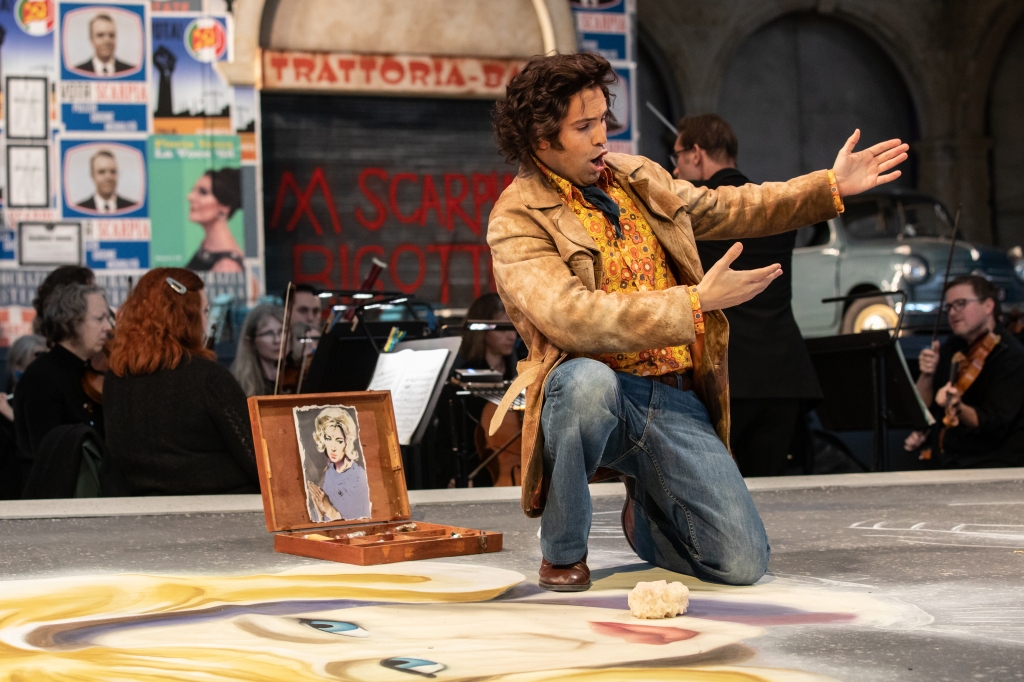
Opera Holland Park has opened the season with Puccini’s operatic blockbuster Tosca.
At OHP the stage was transformed into a back alley in Rome. It was 1968, mid-election, and there was trouble on the streets.
In the opening scene, the police laid into demonstrators, political prisoners hid out in the church, while police chief, Scarpia, issued arrest orders from his trattoria table. His face stared out at us from political posters plastered on the church wall.
The set looked good and was a reprise of Stephen Barlow’s 2008 production of Tosca at Opera Holland Park. I had missed this particular production and was immediately impressed with the emphasis on the political, for Puccini’s opera is not only a love story, but a gripping political drama.
In this Tosca production, the political and the personal played out on different parts of the OHP stage. The stage, shaped like a pair of lips with orchestral pit in the middle, worked beautifully for the most part . On the top stage, or ‘top lip’, we saw the street scenes around the church and trattoria – and when there were important arias to emphasise, the singers came down to the ‘bottom lip’ of the stage to commune with the audience.
There was a problem however with the Tosca-Scarpia scene which is a key moment in the opera. Tosca’s lover Cavaradossi had been captured by Scarpia’s men and agonised cries emerged from the back of the trattoria. Opera productions tend to place this tense encounter, between Tosca and the police chief, in his boudoir at the Farnese Palace. This is where he prepares to seduce Tosca with honeyed words and propose a sexual wager – Cavaradossi’s freedom in exchange for her body.
Unfortunately in this production, the all-important scene unrolled on the upper stage, farthest from the audience, at a cafe table. Did Barlow wish to cut down on what he considered to be the melodrama in this scene? On the night, we watched Tosca stab Scarpia and unceremoniously dump his body inside the cafe. There was certainly shock value in this approach!
Aside my misgivings on stage direction, this was a superb production – buoyed up by an excellent cast.
Amanda Echalaz reprising the role of Tosca she had sung in 2008 at OHP, was supreme. It had been sixteen years since her Tosca debut at OHP. In an interview she gave, she talked about giving her character a more “mature take” this time around.
In the opening scene, Echalaz was striking as the older woman. Striking and a tad intimidating as she towered over her lover Cavaradossi painting the Madonna on the church floor. She was decked out in high sixties fashion, the iconic white boots, wide-brimmed hat placed low over her face and long coat. José de Eça in contrast, as Cavaradossi, was quite a picture in his worn suede jacket and orange shirt and casual jeans, and dismissive of her haughty demeanour. Her fiery outburst as she noticed that the Madonna had blue eyes, not brown (like her own,) displayed not only the vanity of the diva but the distress of the older woman spurned.
Portuguese tenor, de Eça, made a fine young Cavaradossi. His tenor voice swelled in confidence, like his character as he matures, so that when he sang ‘E lucevan le stelle’ in Act 3, I was left thinking that this was a tenor to watch out for in the future. Morgan Pearse sang a whimsical, cruel Scarpia, in his incisive tone. Edwin Kaye as the revolutionary Angelotti, stood out with his powerful bass.
City of London Sinfonia were superb as they continued their fantastic run at OHP (20 years it’s been) and the tragic finale was probably the best in opera I’ve seen for a while.
KH
Remaining performances: June 1, 7, 12, 15, 18, 22 June at 7.30pm. 9th of June at 2pm (Discovery Matinee, audio-described and Relaxed Performance
Discover more from ARTMUSELONDON
Subscribe to get the latest posts sent to your email.